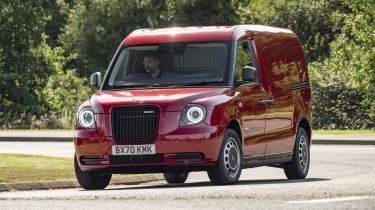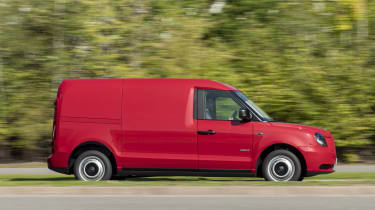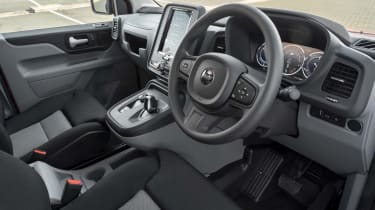LEVC VN5 hybrid van review
Like most electrified vans, the VN5 from taxi maker LEVC is quite steeply priced – but it's also spacious, well equipped and very cheap to run

Pros
- Good electric range
- Drives smoothly
- Quality finish
Cons
- High load floor
- Small dealer network
- Needs bigger mirrors
| Car type | Electric range | Fuel economy | CO2 emissions |
|---|---|---|---|
| Plug-in hybrid | 61 miles | 313mpg | 21g/km |
The Coventry-based, Chinese-owned firm LEVC (London Electric Vehicle Company) is best known for producing the LEVC TX range-extender hybrid London taxi that's becoming an increasingly common sight on the streets of the UK's capital. Now, it has expanded into the light commercial vehicle (LCV) market with this VN5 one-tonne van.
It uses much the same drivetrain and bodywork as the TX, albeit with a 5.5-cubic metre panel-van body, rather than a passenger compartment, behind the driver. That drivetrain sees a 148bhp electric motor turning the rear wheels, powered by a battery that can take power from a public charging point like any regular electric car, but can also be charged up by the van's small internal-combustion engine when necessary.
It's a different concept to equivalent pure-electric vans such as the Citroen e-Dispatch, Peugeot e-Expert and Vauxhall Vivaro-e, but Ford has gone down a similar route with the Transit Custom Plug-In Hybrid van and its Tourneo Custom minibus variant. The VN5 benefits from being designed as a range-extender from the outset, as opposed to converted from a diesel model like the Transits.
It has a larger battery (31kWh versus the Ford's 13.6) and therefore a longer estimated electric range (61 miles versus the Ford's 26). Total driving range with a full tank of petrol for the range-extender engine is pegged at 300 miles; LEVC reckons the VN5 will be able to perform a day's work for almost any operator without needing to be refuelled or recharged. You can manage the battery's energy, too, saving it for use in an urban area while travelling on the motorway, or the van can be left to manage the balance between petrol and electric power as it sees fit to achieve maximum efficiency.
Claimed average CO2 emissions are just 21g/km and making full use of the van's electric range could see a fuel-economy figure north of 300mpg. For charging, the VN5 has two ports in its nose: one a Type 2 for standard charging from a wallbox charger at a home or business premises, the other a CHAdeMO port that can accept the charging cables from public rapid charging points. The latter should take only around half an hour to completely top up the van's batteries. In March 2021, it was announced that all new VN5s would come with a year's free charging from the BP Pulse network for buyers.
On the move, the VN5 is easy to drive and get along with, behaving much like any automatic-gearbox diesel van. It's a lot quieter, though, and this will surely be appreciated by those spending most or all of their working day behind the wheel. There's some tyre noise at speed, but not much. The instant torque from the electric motors proves to be more than sufficient replacement for the low-down grunt of a diesel engine most van drivers will be accustomed to. And the rear-wheel-drive layout puts paid to any wheel-spinning drama when you do pull away quickly, ensuring smooth and rapid progress.
A big advantage of the VN5's London Taxi underpinnings is a very tight turning circle; three-point turns will be a thing of the past on all but the narrowest roads, while manoeuvring around depots or yards will be a breeze. On the flipside, the steering that works so well in tight confines can feel a bit light at speed on the motorway, requiring the odd 'course correction' from time to time. The other downside we noticed while driving is the fairly small rear-view mirrors, which can't match the double-height mirrors found on many medium-size vans.
The total load capacity of 5.5 cubic metres and payload of 830kg aren't game-changing figures for the class, but should be more than sufficient for most needs – particularly the urban delivery jobs the VN5 is mainly intended for. The load bay is 1,373mm high, 1,574mm wide and 2,447mm long. The cargo compartment floor is perhaps higher than would be ideal, but this is necessary to accommodate the battery pack, while the sliding side door opens to reveal an opening just over 1.1 metres wide.
The rear doors can be locked open at either 90 or 180 degrees, while there are four lashing points built into the floor. A steel bulkhead separates the load compartment from the driver's cabin, which has a strictly two-seater layout – there's no option to add a bench seat to accommodate three up front.
There are no armrests with the seats, while the position of the driver's seat relative to the door means there's no natural position to place your elbow on the door card. LEVC makes great claims about cabin comfort, but this is something that could do with addressing to make the VN5 even more comfortable to drive.
The VN5 is offered in three trim levels – Business, City and Ultima – and even the entry-level version is well equipped. Anyone who's driven a current Volvo will recognise a lot of the switchgear and components inside – evidence of LEVC belonging to the same parent company (Geely) as the Swedish brand. There's a nine-inch portrait-orientated screen, automatic LED lights, automatic wipers, Bluetooth, twin USB ports, dual-zone climate control and keyless start. The top-spec Ultima model has luxury-car features like a heated windscreen, heated seats with power adjustment, sat nav and side curtain airbags.
There's also lots of Volvo-sourced safety kit, including autonomous emergency braking, adaptive cruise control and plenty of airbags, while kit such as lane-departure warning, road-sign recognition, front and rear parking sensors and a rear-view camera all available as cost options.
It's a good job the VN5 is so well equipped, even in entry-level form, as it's undeniably expensive compared to diesel-engined alternatives. Even with the government's £8,000 plug-in van grant deducted, you still need to find at least £38,500 (or the equivalent monthly lease amount) to get behind the wheel. But against that has to be ranged the very impressive fuel-economy figures mentioned earlier – daily running costs will be significantly less than those of a diesel van.
VN5 customers enjoy a five-year/150,000-mile warranty for the van and drivetrain, with coverage extending to eight years/150,000 miles for the battery. Both guarantees can be extended (to six years/200,000 miles and eight years/200,000 miles respectively) at extra cost.




